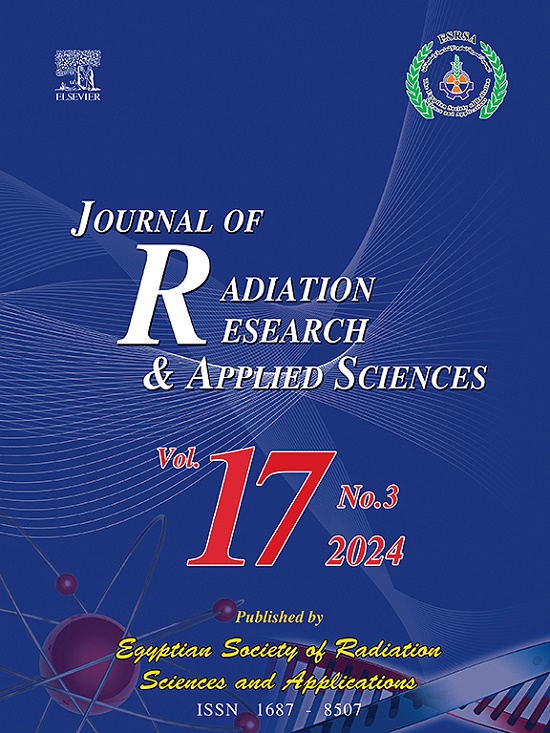Artificial intelligent-powered detection of breast cancer
IF 1.7
4区 综合性期刊
Q2 MULTIDISCIPLINARY SCIENCES
Journal of Radiation Research and Applied Sciences
Pub Date : 2025-03-19
DOI:10.1016/j.jrras.2025.101422
引用次数: 0
Abstract
Breast cancer (BC) is characterized as uncontrollable growth of breast cells. Accurate screening of patients suspected with BC is crucial for timely treatment and minimizing cost. Medical expert relies on several techniques such as biopsy, ultrasound, mammography, Magnetic Resonance Imaging (MRI) etc. Despite reliance on these techniques, majority have drawbacks which include high cost, miss-diagnosis and miss-interpretation, false positive results. As result of the growing number of patients diagnosed with BC, radiologists are facing increase in workload which can delay diagnosis and increase susceptibility or prone to error. Integrating Artificial intelligence techniques into routine pathology practice have shown to reduce workload, errors and improve diagnostic efficiency. Therefore, in this study, we proposed the application of ensemble Deep Learning and Machine Learning approach for the detection of BC from both histopathological and ultrasound images. We curated 4 datasets from Kaggle repository which include 2 histopathological datasets (Breast Cancer Dataset (BCD) with 7783 images and BreaKHis 400X dataset (BH400X D) with 1693 histopathological images) and 2 ultrasound datasets (Ultrasound Breast Classification Dataset (UBCD) with 9016 images and Breast Ultrasound Images Dataset (BUID) with 1578 images. The acquired images are processed via resizing and colour enhancement and trained using customized CNN (D-ResNet) and 5 pre-trained models (ResNet101, ResNet50, VGG16, VGG19 and MobileNet) coupled with Random Forest (RF). Evaluation of the models based on unseen dataset resulted in 95.98 % accuracy using D-ResNet-RF validated on BCD, 92.34 % accuracy using D-ResNet-RF validated on BHX400, 84.82 % accuracy using ResNet101-RF validated on UBCD and 94.32 % accuracy using VGG19-RF validated on BUID.

人工智能驱动的乳腺癌检测
乳腺癌(BC)的特点是乳腺细胞的不可控生长。准确筛查疑似BC的患者对于及时治疗和降低成本至关重要。医学专家依靠多种技术,如活检、超声、乳房x光检查、磁共振成像(MRI)等。尽管依赖于这些技术,但大多数都有缺点,包括高成本,漏诊和漏诊,假阳性结果。由于越来越多的患者被诊断为BC,放射科医生面临着工作量的增加,这可能会延迟诊断,增加易感性或容易出错。将人工智能技术整合到常规病理实践中可以减少工作量,减少错误,提高诊断效率。因此,在本研究中,我们提出应用集成深度学习和机器学习方法从组织病理学和超声图像中检测BC。我们从Kaggle数据库中整理了4个数据集,其中包括2个组织病理学数据集(乳腺癌数据集(BCD) 7783张图像和BreaKHis 400X数据集(BH400X D) 1693张组织病理学图像)和2个超声数据集(超声乳腺分类数据集(UBCD) 9016张图像和乳腺超声图像数据集(BUID) 1578张图像)。获取的图像通过调整大小和颜色增强进行处理,并使用定制CNN (D-ResNet)和5个预训练模型(ResNet101, ResNet50, VGG16, VGG19和MobileNet)结合随机森林(RF)进行训练。基于未见数据集的模型评估结果表明,在BCD上验证的D-ResNet-RF准确率为95.98%,在BHX400上验证的D-ResNet-RF准确率为92.34%,在UBCD上验证的ResNet101-RF准确率为84.82%,在BUID上验证的VGG19-RF准确率为94.32%。
本文章由计算机程序翻译,如有差异,请以英文原文为准。
求助全文
约1分钟内获得全文
求助全文
来源期刊

Journal of Radiation Research and Applied Sciences
MULTIDISCIPLINARY SCIENCES-
自引率
5.90%
发文量
130
审稿时长
16 weeks
期刊介绍:
Journal of Radiation Research and Applied Sciences provides a high quality medium for the publication of substantial, original and scientific and technological papers on the development and applications of nuclear, radiation and isotopes in biology, medicine, drugs, biochemistry, microbiology, agriculture, entomology, food technology, chemistry, physics, solid states, engineering, environmental and applied sciences.
 求助内容:
求助内容: 应助结果提醒方式:
应助结果提醒方式:


